#Armenian legal Center
Explore tagged Tumblr posts
Text
Just leaving these articles here.
Feel free to reblog.
And an additional article from the 9th of September I added later.
Here is a link to the resolution proper.
Also this too. Yeah it’s a week or two late but I somehow missed it back then. I was busy.
#dougie rambles#news#europe#caucasus#armenia#artsakh#free Artsakh#miatsum#azerbaijan#fuck Azerbaijan#Azerbaijan is a terrorist state#leftism#anti fascism#anti imperialism#genocide#ethnic cleansing#IAGS#international association of genocide scholars#feel free to reblog#reblog the shit out of this#report#Armenian legal Center
16 notes
·
View notes
Text

[Image description: A poem titled "רַבִּי / رَبِّي" written Friday, November 17, 2023: Rabbī, I cannot praise your deeds. / Rabbī, no weeping moves you. / Rabbī, your justice is wedded to perversion. / Rabbī, your love looks much like your hatred. / Rabbī, the patriarchs have been gilt as idols. / Rabbī, the Temple has been built into a prison. / Rabbī, mixed multitudes have been spat on. / Rabbī, all oneness has been sported with. / Rabbī, ministering angels have been consigned to wailing. / Rabbī, nameless infants have been fed the world’s silence. / Rabbī, your reddened sea has been exiled from shore. / Rabbī, your holy city has been split in two. / But by whom? / Rabbī, shall I say “them” or “us”? / Rabbī, which people is solely yours? / Rabbī, what image is divine alone? / Rabbī, when comes the Hour of Unlocking? / Rabbī, where hides the Place of Its Glory? / Rabbī, why? Answer now. Answer. End image description.]
note 1: as the title implies, "rabbī" may be read as the hebrew word for "a jewish cleric" or the arabic word for "my l_rd" (i.e., g_d).
note 2: this poem is written from an anti-zionist jewish perspective. therefore the question "by whom? / shall i say 'them' or 'us'?" is not meant to dispute palestine as the oppressed party. rather, it is meant to be taken extremely literally, because it is situated in my individual experience: should i—a muslim in the process of converting to judaism, who has been estranged from jewish community and had my conversion delayed because of zionism; who has no personal ties to israel but is nevertheless complicit in its genocidal actions by nature of living in the warmongering USA which uses my household's tax dollars to fund it; who believes that "all israel are responsible for one another" (shevuot 39a)—refer to the oppressors as "them" or "us"?
ways to help palestine:
decolonize palestine (patreon)
samidoun (calendar of worldwide protests)
palestine action
palestine legal
bds movement
e-sims for gaza
more resources
ways to help congo:
list of donations
boycott & donate
ways to help sudan:
list of donations
fundraiser for a refugee family
action against hunger
ways to help armenia:
all for armenia
armenian food bank
artsakh housing fund
armenian assembly of america action center
ways to help other indigenous peoples around you:
learn about whose land you may be living on
807 notes
·
View notes
Text
THE HAGUE, Netherlands -- A human rights organization representing ethnic Armenians submitted evidence to the International Criminal Court on Thursday, arguing that Azerbaijan is committing an ongoing genocide against them.
Azerbaijan’s government didn't immediately comment on the accusations. The neighboring countries have been at odds for decades over the disputed territory of Nagorno-Karabakh, and are already facing off in a separate legal case stemming from that conflict.
Lawyers for the California-based Center for Truth and Justice, or CFTJ, say there is sufficient evidence to open a formal investigation into Azerbaijani President Ilham Aliyev and other top leaders for genocide. They have submitted a so-called Article 15 communication urging the court’s chief prosecutor Karim Khan to look into alleged atrocities.
Khan’s office will now consider the evidence submitted and determine if the court will open an investigation, a decision expected to take months.
“My goal here is to get the highest bodies that protect human rights to take some action, not just mere words,” Lala Abgaryan, whose sister Gayane was killed by Azerbaijani soldiers in 2022, told The Associated Press.
Her sister’s body was badly mutilated and images of the abuse were spread online. Abgaryan says the pictures were so heinous that she suffered psychological damage after looking at them.
Long-standing tensions between Armenia and Azerbaijan erupted in 2020 into a war over Nagorno-Karabakh that left more than 6,600 people dead. The region is within Azerbaijan but had been under the control of ethnic Armenian forces since the end of a separatist war in 1994.
Last year, following a lightning military campaign, Azerbaijan retook the disputed territory. After Azerbaijan regained full control of Karabakh, which had a population of around 120,000, more than 100,000 of the region’s ethnic Armenians fled, although Azerbaijan said they were welcome to stay and promised their human rights would be ensured.
Prior to Azerbaijan’s offensive, Armenia and former International Criminal Court chief prosecutor Luis Moreno Ocampo accused Azerbaijan of committing genocide by creating conditions aimed at destroying Karabakh Armenians as a group.
A group of around 30 people gathered in the rain in front of The Hague-based court Thursday to hand over more than 100 pages of documents.
The rights organization said it has submitted a dossier of evidence containing the testimony of more than 500 victims and witnesses.
“These atrocities are captured on social media, by Azerbaijani soldiers themselves, where you hear them laughing, making comments, and taking the dead bodies that they’ve just slaughtered and beheaded,” CFTJ leader Gassia Apkaria told the AP.
Legal experts say that genocide may be out of reach for the court. Armenia is a member of the ICC, but Azerbaijan isn't, leaving prosecutors with jurisdiction only over crimes committed on Armenian territory. Nagorno-Karabakh is internationally recognized as part of Azerbaijan.
Forcing nearly the entire population to relocate to Armenia, however, could fall within the court’s remit. Deportation is considered a crime against humanity.
“There is no way this was an exodus by chance,” says Mel O’Brien, an associate professor of international law at the University of Western Australia and genocide expert.
The court has moved forward with an investigation under similar circumstances into possible crimes committed by Myanmar against the Rohingya minority group. While Myanmar isn't a member state, neighboring Bangladesh is and around 750,000 people have fled across the border after being forced from their homes.
The CFTJ’s request came amid two weeks of proceedings between Armenia and Azerbaijan at another global court in The Hague. The United Nations' top court, the International Court of Justice, is hearing arguments related to a pair of cases stemming from the conflict. Each country has accused the other of violating a racial discrimination treaty.
9 notes
·
View notes
Text
‘A life-saving service’
Women’s rights activists lead the charge in Armenia’s fight against domestic violence
By Teresa Di Mauro
Nina rushed to the Women’s Center in Hrazdan when she heard she had a chance to tell her story. As she recounts the abuse she endured at the hands of her husband, her dark brown eyes fill with tears. “I got married in 2012. During our life together, I experienced constant violence. He was very jealous. He would wake up at night and start scolding me or accusing me of cheating,” says Nina, whose name has been changed for her protection.
Nina met her husband when he visited one of his relatives at the hospital where she worked as a nurse. A month after they met, Nina’s family forced her to marry quickly because her grandmother was dying. Her in-laws knew their son was violent towards Nina, but they assured her that after the wedding, “he will stop.” Instead, the abuse continued, even after she became pregnant with the first of their two children.
“I had just given birth. I was wearing trousers, and [my mother-in-law] told me to take them off and wear something more appropriate,” Nina recalls. “She and my husband started beating me and forced me to take off my trousers. My body was bruised.” “They even told my father to come and discipline me because I wasn’t obeying them,” Nina continues. “And my father went along with them so I wouldn’t get a divorce.”
‘A silent crime’
At the time when Nina got married, victims of family violence in Armenia had little recourse. People had only begun to speak more openly about domestic abuse in 2010 following the femicide of 20-year-old Zaruhi Petrosyan. The young woman’s brutal murder at the hands of her husband shocked Armenian society, creating momentum for raising awareness about domestic violence.
The Women’s Support Center (WSC) in Yerevan, an advocacy and support group for domestic violence victims, was established that same year with funding from the Armenian diaspora and international organizations. Together with other anti-violence groups, the WSC also co-founded the Coalition to Stop Violence against Women to promote systemic change.
“In the beginning, we provided legal aid [and] psychological and social services to women and their children. In the first year, we had about 50 clients come through our doors,” says Ani Jilozian, director of development at the Women’s Support Center. “This was at a time when domestic violence was still very taboo and not talked about in Armenian society. In fact, it was still very much a silent crime. Women felt they had no legal mechanisms to protect themselves.”
Thanks to increased media coverage, the WSC was able to raise awareness among the population and open its first shelter in 2012. “We realized it was a service that wasn’t being offered — and it’s a life-saving service,” says Jilozian.
The Coalition’s advocacy also led Armenia to adopt its first anti-domestic violence law in December 2017. However, while the bill was seen as an important first step in establishing a legal basis for protecting victims, rights organizations were far from satisfied and called for amendments to address the legislation’s limitations. “It was a very flawed law. There were no punitive measures, meaning that domestic violence still wasn’t criminalized. But it was a foundation,” says Jilozian.
The Women’s Support Center opened its second shelter in 2019. But while activists had succeeded in increasing public awareness about domestic violence in Yerevan, the rest of the country was largely left out of the conversation. This is one reason why Nare Hayrapetyan, a long-time environmental and women’s rights activist, decided to set up an NGO in her hometown of Hrazdan to help domestic violence victims and women refugees.
Since its founding in 2019, the Resource Center for Women’s Empowerment has worked tirelessly to support domestic violence survivors and empower women by teaching them new skills, including traditional Marash embroidery (in which the crossed stitches interlink to form geometric shapes that symbolize life and protection). However, attracting funding and donations remains a challenge.
“All the grants go to [organizations in] Yerevan and all the money is spent there. Even if it’s a big project, it goes to the regional grassroots organizations as a sub-grant,” says Hayrapetyan, who runs the center and also works as a fundraiser.
War and its aftermath
“In general, domestic violence is very widespread in Armenia, and violence tends to be normalized. But we also have some negative developments that can be linked to the aftermath of the Karabakh war,” says psychiatrist Aram Hovsepyan, the president of the Armenian Mental Health Association.
The war with Azerbaijan in 2020 lasted just six weeks but resulted in more than 7,000 military casualties and around 170 civilian deaths. It ended with a Moscow-brokered ceasefire that saw Azerbaijan regain part of Nagorno-Karabakh and adjacent territories Armenia had captured in the 1990s. The hostilities displaced more than 130,000 people, though the vast majority soon returned home.
“We have an increase in the number of people with post-traumatic stress disorder (PTSD), which usually leads to violence, and we have a general change in the basic mental attitude of men,” Hovsepyan explains. According to the psychiatrist, the war led some men to “adopt a more traditional stance as a defensive mechanism,” using their role as “defenders” to justify violent behavior. “They feel it is their right to be aggressive to become better defenders.”
In the four years since, the Women’s Support Center in Yerevan has seen its caseload triple, while the number of high-risk domestic violence cases they’ve handled doubled. However, WSC staff note that during the 2020 war and its immediate aftermath, there were fewer reported cases, as people fleeing the hostilities were focused on day-to-day survival; many war-related domestic violence cases came in a year or two later.
Following Azerbaijan’s seizure of Nagorno-Karabakh last September, which drove more than 100,000 ethnic Armenians from the disputed enclave, Jilozian believes the same trend is bound to repeat itself. “After the forced displacement [last year], we had about 30 domestic violence cases between September and December, which is actually higher than we expected because that was a really turbulent period where people were relocating,” she says. “Now, we’re seeing [the number of cases] trickle back down. [But] I’m sure that as time goes on, a year or two from now, we’ll see more and more women coming to us.”
Astghik (a pseudonym) used to be a teacher in Nagorno-Karabakh. She separated from her abusive husband in 2019 and struggled for years to create financial stability for herself and her two daughters. Then, last September, Astghik and her children were among those forced to flee to Armenia, where she found herself living in the same town as her abuser. “I don’t want to get into it, but my loved ones weren’t very much help even in these circumstances,” she says.
Astghik turned to the Resource Center for Women’s Empowerment in Hrazdan for help — and she wasn’t the only one. Hayrapetyan says her center, like the one in Yerevan, saw an increase in domestic violence cases after last year’s exodus, which staff also link to a corresponding rise in PTSD cases. “After 2023, the number of cases increased due to post-traumatic stress disorder. [The center] was a new service for Karabakh women. No one talked about domestic violence [there],” says Zhanna Hakobyan, who runs the domestic violence section at the Women’s Empowerment Center.
Like other refugees from Nagorno-Karabakh, Astghik had to try and rebuild her life from scratch. A year later, her living situation remains precarious. “I rent a house that’s not in very good condition; it’s not even hygienic. My children sleep on broken beds [with] torn mattresses that are very dirty no matter how much you clean them,” she says. “I don’t have the money to buy clean beds for my daughters, not even second-hand ones. They miss our old house and the conditions we used to live in.”
Breaking the chains of violence
Thanks in part to the work of the Women’s Support Center and the Coalition, the Armenian Parliament adopted a substantial package of amendments to the 2017 anti-domestic violence law, which came into force in July. This included removing the reference to “restoring family harmony” from the law’s title after rights activists argued that it could be used to pressure victims into staying in abusive relationships.
“Since 2018, there had been two minor changes to the law, but it’s only with this latest draft that there were major substantive changes,” says Zaruhi Meljumyan, a criminal lawyer at the Women’s Support Center.
The amendments provide greater protection and support for survivors, including a clearer definition of abuse, enhanced legal protection for children who witness violence, expanded medical care for victims, and stronger measures to hold perpetrators accountable for their crimes. The amendments also introduce the term “intimate partner,” expanding the scope of the law to include dating couples, people in common-law marriages, and same-sex partners.
According to Leo Zatikyan, a community officer at the LGBTQ+ rights organization Pink Armenia, LGBTQ+ people are particularly vulnerable to abuse from their parents or other family members — and may end up perpetuating the cycle of violence themselves. “When an LGBT person or a queer person starts to have their own relationship, they [sometimes] can’t help but repeat the patterns of their parents or the household they grew up in,” Zatikyan says.
Even before the overhauled law came into force, Armenian authorities noted that the number of criminal investigations concerning domestic violence practically doubled in 2023. They say this is due in part to an increase in reporting rates as opposed to a rise in violence.
For Jilozian, the increased number of reported domestic violence cases indicates at least one positive trend: more women in Armenia are getting themselves out of danger. Moreover, she says, they’re doing so sooner than before. “Women used to come to us in their mid- to late-thirties, but now, on average, they’re still in their twenties. So that suggests that they’re able to break the chains of violence [earlier],” Jilozian explains. “And, for the first time, we’re seeing women in intimate relationships coming to us even before marriage, which was completely unprecedented 10 years ago,” she adds.
After years of psychological and physical abuse, Nina was able to separate from her husband, who was later convicted of stalking her. The police issued a restraining order against him, which expired in May.
Nina’s children remain in the care of her husband and his family. She’s still in the process of fighting for custody, but her court date keeps getting postponed. “I saw my daughter recently when she was at school. But I haven’t seen my son,” Nina says. “His birthday was in May. I went to their house on a rainy day; I knocked on the door several times, but nobody opened it. I even brought a gift with me.”
Astghik’s main priority is also her children’s welfare. “I have been able to feed them for the last three months,” she says. “I don’t know what the future holds, but I will continue to work. My only problem is that I don’t have time to spend with my daughters.”
Thanks for reading!
This month marked one year since Azerbaijan launched a blitz offensive that forced more than 100,000 Armenians to flee Nagorno-Karabakh. You can read The Beet’s reporting on the breakaway region’s fall and the ensuing exodus here and here.
3 notes
·
View notes
Text
Happy month of men mental health!! ʕ·ᴥ·ʔ
Bro, if you can see this, please know that I am so damn proud of you and that you are here! I know you've been through a lot and often you didn't even have anyone to turn to for help, I know what it's like for men, But remember that you are never alone. This is for all men on this planet: don't think you need to be manly and brave all the time, and if you feel bad (which happens to everyone), just tell someone about it and I guarantee you that no one will laugh at you about it. You can tell your girlfriend, parent, sibling or trusted adult for example teacher, or even ask your another male friend "You want to hug?" You really may need it as much as the next man and don't be ashamed of it!!! ಥ‿ಥ
Professional help:
Armenia ( National Domestic Violence Hotline)- +374 105 428 280800 80 850,( Infolinia Fundacji Charytatywnej Armenian Lighthouse)- 2080
Belarus: (National Free Children's Helpline)- 8 801 100 8 801. (Safe Migration Hotline)- 113
Croatia: (Harbri Telephone (children's helpline))- 116 111. (SOS hotline for victims of human trafficking)- 0800 77 99
Cyprus: (Emergency Help Center)- 1440
Czech Republic: ( DONA line)- +420 251 51 13 13. (Children's safety line)- 116 111
Denmark: ( Lew Uden Vold)- 1888
Estonia: (Tugitelefon)- 1492
Georgia: ( National Domestic Violence Hotline)- 309 903
Greece: (National Center for Social Solidarity (EKKA) (for people in various crisis situations, including domestic violence))- 197. (General Secretariat for Gender Equality)- 15 900
Iceland: ( Infolinia schroniska Kvennaathvarfið)- 561 1205
Ireland: (Nationwide toll-free hotline)- 1800 341 900
Italy: (Donne przeciw przemocy)- 1522
Kosovo: (Direct line for victims of violence)- 0800 11112. (SOS Linja)- +381 39 033 00 98
Latvia: (Marta Center for Victims of Human Trafficking)- 800 2012. (Crisis hotline)- 6722292227722292. (Children's Fund hotline)-116 111
Luxembourg: (Fraentelefon)- 12 344
Macedonia: (National SOS Line)- 15 700. (National SOS line) – helpline 15 315. (National SOS mobile line)- +389 75 141 700+389 77 141 700+389 70 141 700
Moldova: (Helpline)- 8008 8008
Montenegro: (SOS hotline for victims of violence)- 080 111 111
Netherlands: (Veilig Thuis (for victims of domestic violence and child abuse)- 0800 2000
Norway: (National hotline for survivors of sexual abuse)-800 57 000. (Crisis helpline)-800 40 008
Poland: (National Emergency Service for Survivors of Domestic Violence Blue Line)-22 668 70 00. (National Emergency Service for Victims of Domestic Violence)- 801 12 00 02
Russia: (ANNA (National Center for Counteracting Violence)-08800 700 600
Serbia: (Domestic violence helpline)- 0800 100 600
Spain: (Hotline for information and legal advice on gender-based violence)- 016
Switzerland: (Dargebotene Hand (crisis helpline))- 143
India: (Hürriyet domestic violence hotline)- +90 212 656 9696. (Social Care Counseling Line for Family, Women, Children and Disabled People)- 183
Ukraine: (Hotline for counteracting domestic violence and protecting children's rights)- 0800 500 3350800 500 336
UK: (ENGLAND: National free domestic violence helplineENGLAND: Rape crisis helpline)- 0808 2000 2470808 802 999. (NORTHERN IRELAND: 24-hour domestic and sexual violence helpline)- 0800 917 14 14. (SCOTLAND: Scottish Domestic Violence Helpline Scottish Domestic Violence Helpline)-0800 027 1234080 88 01 03 020808 8010 302. (WALES: Free Live Fear Helpline Rape Crisis Helpline)- 0800 8010 8000808 802 9999
I hope I didn't mess it anywhere, I love you guys hahaha (◍•ᴗ•◍)❤
05.06.24
22:08
#blogger#self h@rm#vent post#polska#samookaleczanie#sh cvt#self assessment#motylki any#mental health#mental illness#actually mentally ill#boys#boy ana#good men#chce byc lekka jak motylek
4 notes
·
View notes
Text
4/24/2024
April 24 marks the 109th anniversary of the Armenian Genocide. On April 24, 1915, the Ottoman Empire detained and executed numerous Armenian intellectuals and community figures in Constantinople (present-day Istanbul). This marked the beginning of widespread massacres of Armenian men throughout Ottoman territories, in addition to the forced deportation of Armenian women, children, and elderly individuals into the Syrian Desert. The atrocities ultimately resulted in the deaths of more than one million Armenians, representing approximately 70 percent of the Armenian population within the Ottoman Empire.
Today should also bring attention to the current atrocities being committed against Armenians in Azerbaijan. In an offensive that began on September 19, 2023 the Azerbaijan army gained control of Nagorno-Karabakh which is a landlocked area in the Caucasus Mountains that lies within Azerbaijan's borders. It is internationally recognized as part of Azerbaijan but is home to around 120,000 ethnic Armenians, who make up the majority of its population and reject Azerbaijani rule. Most ethnic Armenians–as many as 100,000 people–have now fled the Nagorno-Karabakh region into Armenia. This has raised concerns both about the health and safety of refugees and the future preservation of the Armenian cultural heritage they are leaving behind, including centuries-old Armenian churches and monasteries.
Our allies at Human Rights Watch have followed this situation and have called for a right to return for these refugees. If you want to learn more you can read about it on their page here: https://www.hrw.org/tag/nagorno-karabakh
Beyond the plight of ethnic Armenians today, remembering the Armenian Genocide of 1915 is important because we know the horror of genocide is being inflicted on other populations. Currently in Gaza, the Palestinian people face an ongoing humanitarian crisis because of the genocidal assault being conducted by the Israeli military.
Through our sister organization, the Cultures of Resistance Network, we support many groups that advocate for the Palestinian people. Here are two to follow and contribute to:
Medical Aid for Palestinians is providing much needed emergency relief in Gaza. Support them here:
The Center for Constitutional Rights (CCR) is supporting legal actions to end US military and diplomatic complicity in genocide. To learn more about CCR, please visit:
Pic credits (@instagram)
1- @nancykric
2- @realhistoryuncovered
3- @old.yerevan.no1
4- @dating_pilipinas2




0 notes
Text
ECOS History

For those who choose a cloud mining provider, the history of the company and its legality are very important. No wonder, because they trust the company with their funds and hopes for the future. In our articles, we ourselves often recommend checking providers and choosing reliable partners that have been on the market for a long time. Therefore, we have prepared a brief history of ECOS!
ECOS was founded in Hrazdan, Armenia in 2017. Yes, we have been working on the cryptocurrency market for more than 5 years. Sometimes it seems that we are the oldest team on the market, but in this context it’s cool. Why Razdan? The fact is that the Hrazdan hydroelectric power station is located near this city, with which in February 2018 we signed a direct agreement on the power supply of the data center with a total capacity of up to 200 MW. This has enabled us to provide equipment with stable and cheap energy at a special price, and provide customers with a profitable and reliable product for the next years.
In August of the same year, together with the Ministry of Economic Development of Armenia, we established a Free Economic Zone in the city of Hrazdan and became the operator of the free economic zone. The purpose of the participation of the Armenian government in this project was to stimulate foreign direct investment and the investment attractiveness of the country, as well as to create jobs and export-oriented IT products. The goal of ECOS was to create preferential economic conditions and tax exemptions, which made it possible to provide customers with even more favorable mining conditions (no one else in the world has such conditions).
With the growth in the number of equipment and attracted users, ECOS opened offices in Yerevan and Moscow. And in January 2020, we entered into a partnership agreement with the Russian concern Rosenergoatom on the placement of mining equipment on the territory of the Kalinin NPP in Udomlya. However, the expansion of the company did not end there.
Having expanded the geography of our presence, we decided to expand the list of services provided, and in 2021, a wallet, an exchanger and crypto portfolios were added to cloud mining. Also, for the convenience of old users and attracting new ones, we launched our own mobile application, available in the App Store and Google Play. Over a hundred thousand people have already downloaded it in one year.
And what other results have we achieved during this time? Here are some facts:
300,000+ customers worldwide
173+ countries of our customers
5,000,000+ completed transactions
1,000+ giveaways held
2,000+ auctions held
200+ employees worldwide
1st place for Cloud mining in all search engines
5,000+ articles about us
We continue our crypto expansion and hope that you will also join the number of ECOS users, because we are honest, reliable and profitable. Check it out for yourself right now!
If you planned to start mining, you can do it right now! Buy a contract from $100 and check your profit daily in the personal account!
0 notes
Text
Queens Woman Sentenced for Visa Fraud Scheme

25 Months in Prison for Leading an International Conspiracy
A Complex Web of Fraud and Deception In a significant crackdown on visa fraud and immigrant smuggling, Stella Boyadjian, a 53-year-old resident of Rego Park, Queens, has been sentenced to 25 months in prison. The sentencing took place in Brooklyn's federal court, where United States Chief District Judge Margo K. Brodie delivered the judgment. Boyadjian's guilty plea in March 2019 brought to light a multi-year conspiracy involving visa fraud, identity theft, and the smuggling of Armenian citizens into the United States for profit. The Operation Unveiled Boyadjian spearheaded a transnational network that exploited the P-3 "Culturally Unique Artist" visa classification. This visa allows foreign nationals to enter the United States temporarily to perform or teach as artists or entertainers in a culturally unique program. Furthermore, Boyadjian's operation involved falsely claiming that Armenian applicants were members of performance groups eligible for these visas. Additionally, she charged them between $3,000 and $15,000 for inclusion in fraudulent petitions. Exploiting Cultural Heritage for Profit Operating under the guise of the Big Apple Music Awards (BAMA) Foundation, Boyadjian utilized her connections within the music industry in both the United States and Armenia to perpetuate her scheme. With meticulous planning, she and her co-conspirators staged photo sessions with the Armenian applicants wearing traditional folk costumes to fabricate evidence of their cultural uniqueness. These forged documents and staged photos were then presented to U.S. consular officers during visa interviews, following intensive coaching on how to respond to questions from USCIS visa adjudicators. The Fallout and Investigation The scheme not only misled USCIS but also exploited the cultural heritage of Armenia for personal gain. Furthermore, the investigation, led by the U.S. Department of State’s Diplomatic Security Service (DSS), with support from the USCIS Fraud Detection and National Security Center, unveiled the depth of Boyadjian's operation. This case underscores the vigilance of federal agencies in detecting and prosecuting those who exploit the immigration system. A Wider Impact on Immigration Policy Boyadjian's sentencing sends a strong message about the consequences of manipulating the United States' immigration system. Additionally, it highlights the ongoing challenges in balancing the facilitation of legitimate cultural exchange with the need to protect against fraud. The case also raises questions about the effectiveness of current vetting processes and the potential for similar schemes to exploit weaknesses in the system. A Lesson in Integrity Stella Boyadjian's case serves as a stark reminder of the importance of integrity within the immigration process. Moreover, as the United States continues to welcome individuals from around the world, maintaining the integrity of its visa programs is paramount. This sentencing reinforces the commitment of the United States to uphold the law and ensure that those seeking to enter the country do so with honesty and respect for its legal frameworks. Sources: THX News & U.S. Attorney's Office. Read the full article
#Armeniancitizens#BigAppleMusicAwardsFoundation#EasternDistrictofNewYork#fraudulentperformercertificates#identitytheft#immigrantsmuggling#P-3CulturallyUniqueArtistvisas#USCISfraud#USCISvisaadjudicators#visafraudscheme
1 note
·
View note
Text
If “genocide” means any horrible action by one group against another, then it loses its specific moral and legal meaning. It becomes just another word that partisans use against one another. I’m pro-Palestine, therefore I call this a genocide; you’re pro-Israel, therefore you deny it. That represents a terrible loss for the rule of law, and the persecuted minorities that are the targets of actual genocide. No one who cares about minority rights, indigenous rights, or human rights should be cavalier in the use of this term. Finally, it does not aid the cause of Palestinians to level this charge. The genocide charge enflames hatred against Israel, and in turn exacerbates Israelis’ sense of being alone and isolated in a world of antisemites who will say anything against them. All that supports the extremists on Israel’s right wing. This is not to suggest that solidarity with Palestine means supporting the Israeli action — that would be ridiculous. It is simply to say that all of us — left, right, and center; sympathetic to one side or the other or both — need to be careful with language and contribute to some eventual resolution, or at least mitigation, of this conflict. Painting the enemy in terms of good and evil does a disservice not merely to the “other side” but to the very prospect of coexistence between two peoples with complex and interwoven histories.
War is not genocide. Even the war crime of intentionally targeting civilians is not genocide. Genocide is a crime against humanity that encompasses the intentional extermination of an entire people. It is a major charge, a capital one. It is rare, too: in the 20th Century we see the Herero, Armenian, Holocaust, Rwandan, and possibly Bosnian genocides. The crimes of Stalin's regime against the Kalmyks, the ethnic cleansing of Jews from the Muslim world, the violence of India's partition, and more recently the ethnocide against the Uighur and Russian plans to eradicate Ukrainian distinctive identity, don't reach this high plateau. If your definition of "genocide" is so broad that it can be applied to the experience of German under allied bombs in World War II, then your definition is functionally useless save as an emotionally weighted, manipulative cudgel.
Which is exactly what the misuse of "genocide" is intended to do. Just as Mahmoud Abbas's doctoral dissertation minimized the Holocaust and placed blame for it on Zionists, pro-Palestinians use the charge in order to trivialize Jewish trauma and reduce it to and unfortunate and exaggerated consequence of any conflict. They want to eliminate one of the central reasons Israel exists: as a safe haven for a globally persecuted minority. After all, they deny that life was at all difficult for Jews as dhimam under the burdens and limitations of Muslim world. They need to portray Jews as historically privileged, not as victims, in order to make the case for Israel's elimination, an act that few can seriously deny would be accompanied by another genocide, given the acts and words of the most powerful and popular (not to mention well funded) Palestinian political party and military force.
So you see, those who misuse "genocide" don't want coexistence between two peoples with complex and interwoven histories. They want Jews put back in our place. They believe all the conspiracy theories about our power and influence, our plans for world domination and conquest from the Nile to the Euphrates, and want to strip us of our pride, our confidence, our self-determination, our autonomy, and our freedom. There is no compromise or accommodation with the people who use this language. They are lost causes to be ignored. We must defend ourselves and our interests, deaf to their distortions of language and history. They do not wish us well, and we are under no obligation to negate ourselves for their sake.
0 notes
Text
https://www.pinterest.com/pin/1020206121822828705/ babyy porn
Aaron
I'm not clicking on anything that says baby pron
CRAWL! CRAWL! whyyy caligula whyyy
their kid got pregnant
this was madonna's granddaughter daniella jasso pregnant at 5 years old, they had a fight that morning for holy communion to happen
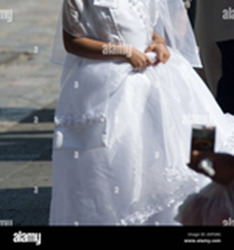
and she lesbo to steal your car, one day was it, they painted it
the monster truck freddy kreuger was it
or which ever grave digger or something they would drive it to church
and live in it
to be virgin mary
she wouldent say it either, virgin mary
madonna's grandpa dennis rodman, and all of them together to talk about it
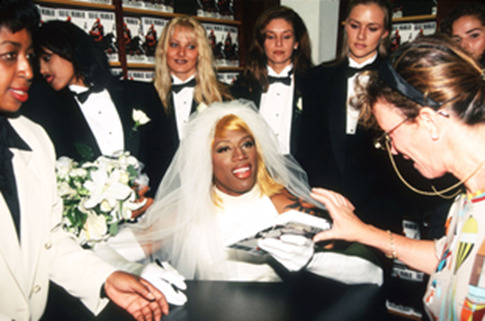
madonna's daughter "mary" had a daughter at 8, and her daughter had one at 5, she wore that dress then

katie/lynn she wore stilts and katie name with older men mated with them
then madonna dressed as the wedding dress that said boy toy on it
she got this drunk, it was legal at 16 in europe to drink

and wine was "im fine with it im fine with it"
she made a veil in gibralter trade center for her granddaughter and i saw it
she looked like a princess diana lucille ball
she said she would put a hat on it, her sister was the godfather, it meant hide me, we can go around again, then get out of my car after, lay in it, stay, house is mine, hers, she went with osama then it was him dennis rodman/ryan/kevin and her madonna in drag, young girls do stupid shit, keep them drunk and on drugs he said it to only her too haha church they all laughed just shoot her aand did bye family
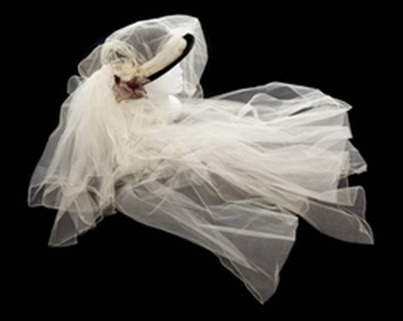
they would joke i guess
her granddaughter said i dont like it and she said i would shoot you at her granddaughter
and talking was don't use names
her daughter looked like lynn
northern europe was it, where women lived
southern was trash going east and west of europe
and tanned
wtf grandmas
dennis rodman was the singer of rage against the machine
their army has mustache's and look armenian
a gaint army of men
black hair, tanned
arab, what did you rub against her and want one
it was constant screaming, lived in a area with themselves
his son osama, and dennis rodman now, dennis rodman is saddam hussein
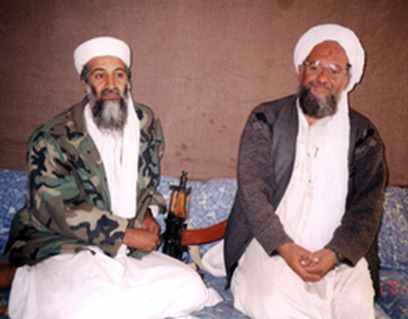
james and jim? both their dads, 4th marriage, first
two s's and two d's thats a basketball dunk
vinnie, and jimmy corbin are related to them
related meant directly descent
they all had boys
steve found out his wife was pregnant again in school parking lot she said it
i was friends with her to he tripped me when he heard it
and at a concert again wtf attack her
they wouldent attack their pregnant wives but did to other people
white trash is it too
anyone who had kids young was totally their mustache army
or man whores
what is it go in the building
said she lived there
they would rob people fight them and hide
they are all it
they would only talk to themselves too, that group of had kids
young
what job you got now fly
Alien Godzilla jumps and leaps over the bridge #shorts
they are all the same too for talking to each other
but are you four?
im only four!
and steal the show yea we got it
the gift of lisa frank is just beginning
i thought wayne screaming was loud
there are mexicans next door that are SCReAMING outside for like half a year
with like 3 parked cars in the driveway
they are building a bathroom downstairs
they would hook it up to a fire hydrant
they just started a generator it sounds like a lawn mower
did they put it inside the house
by the door
back
now its in the kitchen with them
they put acid on it and do it all day
now one is raking in the back yard
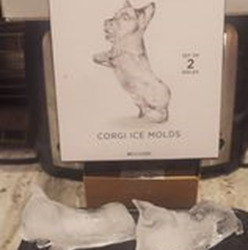
Corgiaholics
$750 dollars for a dog perfume

Miss Dior Blooming Bouquet Collector Edition Bobby Bottle | Dior US
miss precious
bobby get back in the garage
but what if shes half gone
AH LA LA EH YENDE
the neighbor said it LOUD
they only drink inside
then come out agani
they have to drink all the time
and drugs they have sex
the women are inside
or two gay men today haha wtf?
he said it
they threatened me at a store to steal things for them
and they said out loud YEA I SAID IT
and their wife in a car coming out of it looking at me said yea im gonna hit ya
and that guy said yea im gonna hit ya now if you look
she did
bye bitch
two cars we stalked her
liscense plate
where are they from
called a mexican bitch
evicted all of them
that guy said he did
with madonnas credit card
dont want my wife in a church with ya im gay
married elissa their inbred too
daniella married him then
her mom dressed up prettier i wanted her i wanted out
shot her dog too
who cares about her
inbred meant i can go insane all the time
and fleet her i can get in that airplane i followed her
lynn is their mom had to have 4 in three years
ricky, timmy, devin, zach
dont you like my hair
no
to them it meant am i sexy
you wanna fuck me
first we fuck up your relation ship
then her face
then yours
then him next to you
now he fucks up you
and i fuck him from behind after
now you i fuck you
and hey they call out
shes doing it now
i felt her haha
do we save her
no we fuck up the whole area
and everyone in it
judges would not randomly interview
jim is lynn's dad
no i dont like her wedding dress
she had to be blonde for two days to hide from him
her husband
sean penn
and all black kids wtf
i abandoned them
for them to come back and have sex with me
the loudest families are them
and the whole time they talk about how people are turned on by them for letting out the drugs and alcohol and didn’t fuck me yet on drugs and alcohol would stay in a group over there then I got a orgy
and probably you got a problem man, said it to everyone for 32 years to have them leave work and their house to get fucked up, and didn’t leave, entered it and fucked them up
and yea I left a younger one at you so you’d like it, lynn said it
and I like it -lynn
they sent her in to fuck you anyways, anne marie is Lydia/yessica/lisa marie presley/keep a secret that pregnant girl wasn’t me “I wasn’t her” yes! She said it
that was already her inbred and she was Lucille ball
all their kids were ugly nigger Mexicans, I live south of you fuck me, come out in a car he is gay
every pregnant girl in church is it, climbing on the floor to bless each persons feet to suck on them later
and they boy stands outside
who got her pregnant, kevin, im the riff raff girl
lets fuck Michael Jackson first” Madonna said it, it was her dad she inbred with, all them in that photo with dennis rodman at once his daugters
walking slow, five at once, lets go with you, Michael would say it, and hey Japanese lets implode, all pregnant get in there eat till you explode, then tell her to come over
“you know I went with her and she got us flying after” -ricky
Group of labor/litter he called it, run like dogs she said, Madonna
The osamas and sadams sing gay old Spanish it was them talking, and ricky talks back like Cheech marin
0 notes
Text
Mrs. Ferrel-
Nitya Rawal- your Persian American client - still thrown under bus in your backyard!
Can you get my kids for Christmas please?
My name is at bottom of every note you smart atty you. (:
Judge Davis needs to be recalled & every officer on my case smearing me on bribes.
All attys failed real estate and family law dissolution. Need Peace orders now.
Not letting your officers assault me again.
Bribed PD Christopher Stapleton didn't say one word in court yesterday.
Not one word on my behalf.
He's completely failed law and defense as has Sandiego & Riverside PDs. Judge Davis refused to acknowledge 6 years of files. Fire her. not getting roped into lame con.
Very disappointing.
Please settle now & refund for services w/ damages.
BTW Tmobile didn't work with court website for video in all of Mountain Center & DHS.
I really need refunds for federal court/cellular tech issues & harassment/doscrimination of services.
Judge Davis wanted to see me & got her Forensic yet still wants more.
I passed competency 6 times- all orders are expired & charges served. Your staff is borderline Retarded & have never represented us appropriately.
Now we need reperations for foul way attys have abused restraining orders in real estate & family law.
What do you think a mom wants for Christmas?
Her Kids.
Please settle w/ all & get them. Thankyou. I hope your Persian Armenian family is surviving genocide & hollocoast better than your clients & colleagues Slaves. You all have been a disgrace to law.
Please walk your talk if any of you really care about children and #HalfPersianLivesMatter #HalfPrincessesLivesMatter #IranianWomenLivesMatter & stop this war on families at large.
We've diagnosed courts with extreme domestic terrorism con originating from Dr. Sunil Rawal's legal team.
While you were aware of this constitutional violation- your Oath was to the perverted "dick's" capitalism rather than sisterhood.
Your own ass safely with a Judge. No regard for millions of moms in California.
Not your kids or mine. Where's you're pro-bono civil duty to clean this shit up? Women are being raped and murdered that counted on you for family defense. It's a global civil issue with attorney fraud that needs to be addressed immediately.
Thankyou. Dr. Sunil Rawal is at 760-473-6054
Call - settle now!
Merry Christmas!
Peace & Joy,
Nitya Huntley Rawal
0 notes
Text
Just leaving this here.
Feel free to reblog.
#dougie rambles#personal stuff#news#caucasus#europe#azerbaijan#Azerbaijan is a terrorist state#fuck Azerbaijan#united nations#UN committee against torture#war crimes#feel free to reblog#reblog this#reblog the shit out of this#Armenian legal Center#armenia#atrocities#crimes against humanity
4 notes
·
View notes
Text

[Image description: A digital drawing in black and white. A rock dove, white-spectacled bulbul, European bee-eater, Eurasian hoopoe, Eurasian spoonbill, European nightjar, and common nightingale fly together while carrying stones in their talons. Each bird is accompanied by its own name in Arabic. The rock dove has a shining halo around its head and the nightingale also carries a rose. On the top and bottom, two verses in Arabic are written, while the left and right read "VICTORY TO THE / STONE-THROWERS." End image description.]
inspired by qur'an 105:3-4 "for It sent against them flocks of birds, pelting them with stones of baked clay" + the article "how trapped palestinians fell in love with bird-watching."
ways to help palestine:
global strike on monday december 11!!!!
connecting gaza humanitarian aid + e-sims for gaza guide
decolonize palestine (patreon)
samidoun (calendar of worldwide protests)
palestine action
palestine legal
bds movement
legal defense for jerusalem armenians
financial support for palestinian refugee students
support palestinian businesses
more resources
ways to help congo:
communist party of the congo
list of donations
boycott & donate
ways to help sudan:
list of donations
fundraiser for a refugee family
action against hunger
darfur women action group
ways to help armenia:
all for armenia
armenian food bank
artsakh housing fund
armenia fund
armenian assembly of america action center
ways to help other indigenous peoples around you:
learn about whose land you may be living on
wôpanâak language reclamation project
list of donations
more resources
57 notes
·
View notes
Note
THIRD WIFE?! Elvira Lind's husband has been other peoples' husband? EXPLAIN.
Oscar and his first wife Maria Miranda. They were “Childhood sweethearts”. He proposed to her in 2007 at the Lincoln Center fountain, and they got secretly married sometime in the next few years because in 2010 during the Robin Hood press tour he said “I’m lucky to have an understanding wife”

And this doesn’t TECHNICALLY count? But in 2015 he legally married Angela Sarafyan on the set of The Promise by an Armenian priest

She wrote this on her insta: “The priest on the set of @thepromisefilm was a real Armenian priest from Armenia that happened to live in Spain. Etchmiadzin, one of the oldest cities in Armenia, has three sister churches and this is where he was ordained. He actually married us on set, with the true Armenian prayer they would do at any traditional Armenian wedding. Those prayers were true in 1915 and remain the same to this day. In the end, he told us, ‘I need to divorce you, because you are technically married in the eyes of God.’”
So, a technicality, but STILL.
And then he married Elvira, of course. They had initially agreed on not getting married, she was pregnant with their first child when his mom was sick and Elvira was helping taking care of her. He said, “But, you know, at the time, right before it happened, my mom was ill, and so I saw [Elvira] carrying my child, bathing my sick mom — seeing her do that, I just thought, 'I want to be with this person forever and ever,' " And they got married in February 2017. His mom passed in March and their son Eugene was born in April.
53 notes
·
View notes
Text
Meduza's The Beet: Armenia’s winemaking renaissance
Hello, and welcome back to The Beet!
I’m Eilish Hart, the editor of this weekly newsletter from Meduza covering Central and Eastern Europe, the Caucasus, and Central Asia. To the new subscribers who joined us over the holidays, welcome! Thank you for being here and for helping us surpass our end-of-year goal. If you have yet to join our mailing list, that’s one New Year’s resolution you can actually keep — it’s as easy as signing up right here.
To kick off 2024, we’ve got a delectable dispatch from Armenia, where the country’s millennia-old winemaking tradition is experiencing a revival. Though perhaps best known for its brandy — often referred to as “cognac” and historically served up to the likes of Winston Churchill —Armeniais slowly but surely gaining international recognition for its wines. The discovery of the world’s oldest known winery in the country’s southeast helped put Armenia’s ancient winemaking culture back on the map beginning in the 2010s, giving rise to festivals and boosting tourism to the country’s wine regions. But local winemakers often feel that even after more than 30 years of independence, Armenia is still trying to undo the damage to its wine industry wrought by the Soviet Union and its planned economy. For The Beet, Sona Hovsepyan reports on how Armenian vintners are making up for lost time.
Armenia’s winemaking renaissance
By Sona Hovsepyan
The narrow alleyways of Nork-Marash, one of the Armenian capital’s oldest districts, lead to wine cellars with handcrafted wooden doors. Located east of Yerevan’s bustling city center, this hilltop site feels reminiscent of the countryside. In the 19th century, every family in Nork-Marash was involved in making wine from grapes grown in their gardens. But only a few have managed to preserve this custom today.
The Derdzakyans transformed a 19th-century wine cellar inherited from their grandfather, Hovhannes Derdzakyan, into a boutique winery in 2019 to preserve their family history. They named their business Norqi Keghar, which means “wine cellar” in Western Armenian. Norqi Keghar handles the complete production chain and uses traditional methods, maturing their wine in large earthenware pots or Caucasian oak barrels.
Artsrun Petrosyan, the Norqi Keghar Winery’s co-founder, smiled as he displayed the 150-year-old winepress. “Only men crushed the grapes in the winepress. Women weren’t allowed to come close to that work,” he explained, adding that this was a family tradition. He then proceeded to the room where the vats inherited from Hovhannes Derdzakyan are still used to age wine today. Petrosyan covers them with beeswax, giving the wine a mild taste.
‘We gave up our winemaking culture’
Even during the Soviet era, when the authorities expropriated the Derdzakyan family’s vineyards for the benefit of the state, Hovhannes Derdzakyan worked diligently to preserve the local tradition of viticulture and winemaking. “Initially, winemaking was not prohibited in the Soviet Union, but [production] volumes dropped dramatically,” Petrosyan told The Beet. “And Grandfather [Hovhannes] continued his wine sales in a not entirely legal way.”
Under the Soviet Union’s planned economy, other states, such as Georgia and Moldova, were designated for wine production, while Armenia was instructed to prioritize brandy (commonly referred to as “cognac”). Legend has it that Joseph Stalin plied Winston Churchill and Franklin D. Roosevelt with Armenian brandy as they devised a plan for post-war Europe at the Yalta Conference in 1945.
According to Petrosyan, however, the overwhelming emphasis on brandy production dealt a blow to Armenia’s winemaking tradition. “We lost many varieties of grapes,” he lamented. “The Soviet Union caused a lot of damage, and we gave up [our] winemaking culture.”
Mikhail Gorbachev’s anti-alcohol campaignonly made matters worse. In 1985, Soviet officials started destroying vineyards in Armenia, halving wine production. And even after Armenia gained independence in 1991, wine production, like other sectors of the economy, continued to suffer. The Armenian energy crisis of the 1990s, which locals refer to as the “dark and cold years,” compounded the damage from the First Nagorno-Karabakh War between Armenia and Azerbaijan. The winemaking industry slowly began to recover only in the late 1990s, thanks to investment in new technologies.
Thirty years on, Armenia is home to hundreds of indigenous grape varieties, but local winemakers are leading a renaissance with just a handful. The winemaking process officially begins in mid-August, after the Armenian Apostolic Church celebrates the Assumption of the Virgin Mary and the Blessing of the Grapes.
Norqi Keghar’s wines are also produced using native grapes, focusing on quality over quantity. Petrosyan took special pride in their Karmrahyut wine, made from an Armenian red grape variety. “When people ask, ‘How could you surprise us?’ I immediately suggest Karmrahyut wine,” he said. “It has a rich, dark-red hue and a warm taste with a velvety tone.”
‘Armenia has always held its own’
The revival of Armenia’s ancient winemaking traditions dates back to 2007 when archeologists discovered the world’s earliest known winery in a cave in Areni, a village in the southeastern Vayots Dzor province. Archeologist Boris Gasparyan, who co-led the expedition to the Areni-1 cave (known among locals as the “Birds’ Cave”), told The Beet that the artifacts there reminded him of scenes from the 5th century B.C. described by the Greek historian Xenophon, who depicted Armenian winemaking in his most famous work, the Anabasis.
“There were three vats, and in one of them, when we opened the lid, we found reed straws,” Gasparyan recalled. “Upon seeing them, it immediately reminded me of Xenophon’s description. We realized we were dealing with the oldest known wine production facilities.”
The joint Armenian-Irish archaeological team, which also uncovered the world’s oldest leather shoe in the Areni-1 cave, found human remains in earthenware pots, Gasparyan said, suggesting that the winery had a ritual purpose. “Wine was born in a ritual and then entered everyday life,” the archeologist explained.
The team also found grape seeds, the remains of pressed grapes, and dozens of dried vines at the site. Archaeologist Gregory Areshian co-directed the project with Gasparyan and told National Geographic that the prehistoric winery offered “a complete archaeological picture of wine production dating back 6,100 years.”
“The current territory of Armenia and, historically, the entire Armenian Highlands mark the beginning of wine-producing societies in the ancient world,” Gasparyan said. “Armenia has always held its own place in the field of winemaking.” Even in the ancient world, wine was among Armenia’s calling cards, he added. “It is not a coincidence that in the sculptures of Persepolis, when the subjugated nations sent gifts to King Darius, there are Armenians depicted bringing Darius wine and a horse.”
Today, the Areni-1 cave, a two-hour drive from Yerevan, has gained world fame, leading to a noticeable increase in local and foreign visitors. The village of Areni is renowned for its wines, and the discoveries made in the cave gave birth to the Areni Wine Festival, where local vintners present their wares to visitors from around the world. Wine tasting is accompanied by music and dance, with attendees crushing grapes with their feet in the traditional way, just like in ancient times.
Making up for lost time
Not to be outdone, the Armenian capital also has its own annual wine festival. Yerevan Wine Days began in 2017 and usually takes place during the first weekend in June. Saryan Street, a quaint, tree-covered thoroughfare, is blocked to traffic for three days, and local wineries set up stands to showcase their goods. Tourists and locals mingle as they enjoy the wine paired with food and live music. According to the festival’s organizers, it drew more than 60,000 visitors in 2022.
Meanwhile, near the Cascade Complex in the heart of Yerevan, Wine Republic has created its own “ancient country,” where guests order their drinks not from a menu but from a well-stocked wine cabinet. The restaurant’s narrow wooden tables create an intimate, friendly setting for wine tasting that attracts locals and tourists alike.
A framed map of this imaginary country hangs on one wall. “[It’s] a ‘republic’ inspired by European culture and the atmosphere of Yerevan,” explains Wine Republic marketing director Elina Sahakyan. “Everything in this city is about enjoying wine and combining it with dinner. Wine is [really] about ‘wine and dine.’”
Wine Republic has upheld this concept since it opened in 2015, offering primarily seafood, meat platters, and cheeses paired with quality domestic and imported wines — and serving up abundant knowledge with every glass.
“We have customers who try different wines every time and take the corks to remember the ones they tested,” said the manager of Wine Republic, Lusine Kirakosyan.
The Armenian government declared winemaking a priority branch of the economy back in 2016. Officials have also labored to bolster the country’s reputation as a “wine republic.” In the words of former Prime Minister Karen Karapetyan, the ultimate goal is to solidify Armenia’s “place on the global wine map.”
Winemaker Zaruhi Muradyan, the executive director of the Vine and Wine Foundation of Armenia and the owner of the boutique winery Zara Wines, says Armenian wines are indeed starting to turn heads and gain an international reputation. But the industry is still trying to make up for lost time.
“We have a strong history; we have evidence that proves that we produced wine centuries ago. But we have lost that [reputation] over time,” said Muradyan. “If we want to be competitive and recognized today, we must demonstrate our uniqueness.”
Standing out
While the government’s current development plan for Armenia’s wine sector aims to increase the size of vineyards, raise production volumes, and boost sales at home and abroad, Muradyan argues that focusing on quality over quantity would be better. “We do not have a lot of farmland where we can establish vineyards. We should use our resources to produce only the best wine,” she told the Beet.
According to the country’s Customs Service, Armenia exported around 4.8 million liters of wine in the first half of 2022, valued at $18.8 million. While these wines were destined for more than 50 countries, Russia remains the primary export market due to strong trade ties and membership in the Eurasian Economic Union.
“Eighty percent of our products [Armenian wine exports] are consumed in the Russian market, and it will remain an important market, but it is politicized and depends on [current] events,” Muradyan noted.
Armenian exports to Russia have boomed against the backdrop of Moscow’s full-scale invasion of Ukraine and subsequent Western sanctions against Russia. During a recent visit to Yerevan, Russian Deputy Prime Minister Alexey Overchuk said that trade turnover between Armenia and Russia increased by 43.5 percent during the first nine months of 2023. However, this growth is largely attributed to re-exports of Western goods — and the fluctuations of the Russian ruble have directly impacted Armenian exporters.
At the same time, diplomatic spats between Moscow and Yerevan have occasionally spilled over into the realm of trade. In November 2023, for example, Russia refused to allow thousands of Armenian trucks to pass through the Lars checkpoint — the only land road connecting Armenia to Russia via Georgia. (Russia’s agricultural authority claimed that there had been a “sharp increase” of Armenian agricultural imports that violated sanitary standards.)
“Considering these problems, we understand that we need to diversify into other markets,” Muradyan said. In her opinion, Armenia has what it takes to succeed, with its unique terroir and technical grape varieties, and its vintners, who deftly combine traditional production methods with new technologies. “Our creative winemakers spare no effort in representing our country in the best way, which makes us stand out.”
That’s all for this week!
Before I let you go, I’d like to thank everyone who wrote to us in response to our story about Lena Wolfand her family. In case you missed this gripping long-read, it’s now available on Meduza’s website in both English and Russian, along with our bonus podcast interview with Lena herself. Until next time,
1 note
·
View note
Photo

THE MYTH OF THE WHITE RACE!
When the first Africans arrived in Virginia in 1619, there were no “white” people there. Nor, according to colonial records, would there be for another sixty years
By the 18th century, "white" had become well established as a racial term at a time when slavery of African-Americans was widespread.David R. Roediger has argued that the construction of the "white race" in the United States was an effort to mentally distance slave owners from slaves.The process of officially being defined as white by law often came about in court disputes over pursuit of citizenship. The Naturalization Act of 1790 offered naturalization only to "any alien, being a free white person". In at least 52 cases, people denied the status of white by immigration officials sued in court for status as white people.
By 1923, courts had vindicated a "common-knowledge" standard, concluding that "scientific evidence" was incoherent. Legal scholar John Tehranian argues that in reality this was a "performance-based" standard, relating to religious practices, culture, education, intermarriage and a community's role in the United States
WHITE IS A SOCIAL POLITICAL CLASS SYSTEM, WHITE WAS BUILT ON BEING AS BRITISH AND CHRISTIAN AS POSSIBLE. WHITE MEANS HAVING SPECIAL RIGHTS.
WHITE IS A TOOL BY WHICH LABORERS WERE DIVIDED
WHITE SUPERIORITY TO NON WHITES
WHITE CONNECTED EUROPEAN LABORERS(COMMONERS) TO THE BRITISH ELITE(SIMILAR TO HOW RURAL EUROPEAN FEEL CONNECTED TO DONALD TRUMP)
WHITE WAS CENTER OF PATRIARCHAL POWER
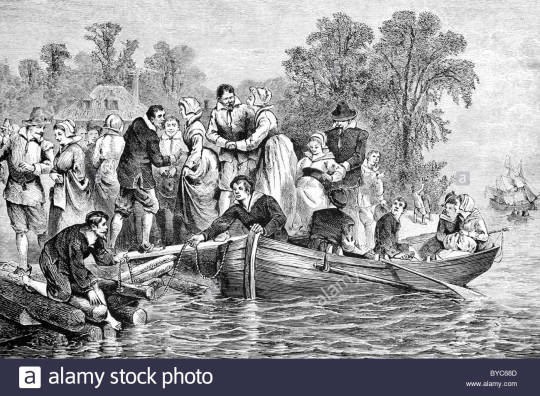
The 2000 U.S. census states that racial categories "generally reflect a social definition of race recognized in this country. They do not conform to any biological, anthropological or genetic criteria.
"It defines "white people" as "people having origins in any of the original peoples of Europe, the Middle East, or North Africa.The Federal Bureau of Investigation uses the same definition

Jacqueline Battalora argues that the first laws banning all marriage between European and Africans, enacted in Virginia and Maryland, were a response by the planter elite to the problems they were facing due to the socio-economic dynamics of the plantation system in the Southern colonies. The bans in Virginia and Maryland were established at a time when slavery was not yet fully institutionalized. At the time, most forced laborers on the plantations were indentured servants, and they were mostly European. Some historians have suggested that the at-the-time unprecedented laws banning "interracial" marriage were originally invented by planters as a divide-and-rule tactic after the uprising of European and African indentured servants in cases such as Bacon's Rebellion. According to this theory, the ban on interracial marriage was issued to split up the ethnically mixed, increasingly "mixed-race" labor force into "whites," who were given their freedom, and "blacks," who were later treated as slaves rather than as indentured servants. By outlawing "interracial" marriage, it became possible to keep these two new groups separated and prevent a new rebellion.
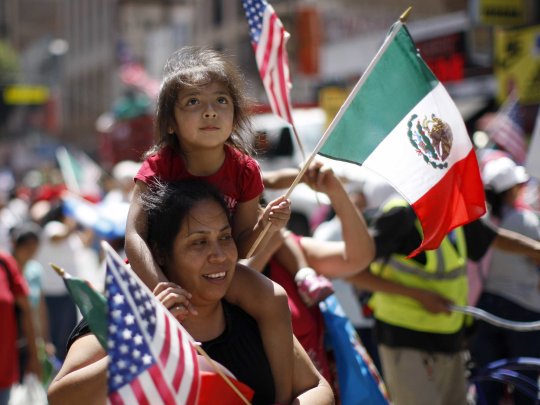
The official racial status of Mexican Americans has varied throughout American history. From 1850 to 1920, the U.S. Census form did not distinguish between whites and Mexican Americans. In 1930, the U.S. Census form asked for "color or race," and census enumerators were instructed to write W for white and Mex for Mexican.In 1940 and 1950, the census reverted its decision and made Mexicans be classified as white again and thus the instructions were to "Report white (W) for Mexicans unless they were definitely of full Indigenous Indian or other non-white races (such as African or Asian)."
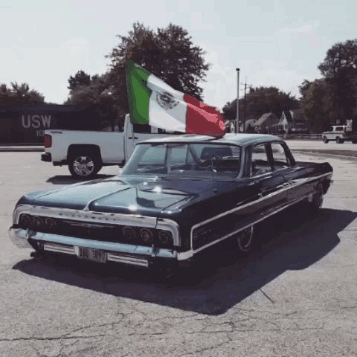
During periods in U.S. history when racial intermarriage wasn't legally acknowledged, and when Mexicans and Mexican-Americans were uniformly allotted white status, they were legally allowed to intermarry with what today are termed non-Hispanic whites, unlike African and Asians. They were allowed to acquire U.S. citizenship upon arrival; served in all-white units during World War II; could vote and hold elected office in places such as Texas, especially San Antonio; ran the state politics and constituted most of the elite of New Mexico since colonial times; and went to segregated white schools in Central Texas and Los Angeles. Additionally, Asians were barred from marrying Mexican Americans because Mexicans were legally white
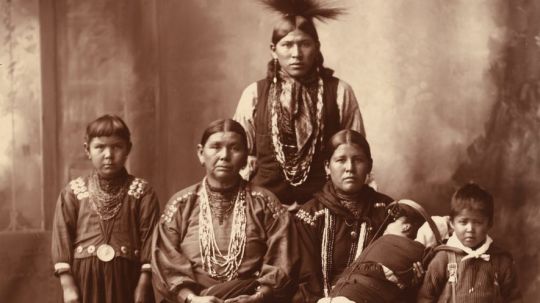
In Oklahoma, state laws identified Native Americans as legally white during Jim Crow-era segregation.
In the late 19th and 20th century, many saw Native Americans as people without a future, who should be assimilated into a larger American culture. Tribal membership was frequently defined according to so-called blood quantum standards (proven through a Certificate of Degree of Indian Blood), so that people of mostly white ancestry and more distant Native ancestry were denied any formal ties with their ancestral tribe. This led to the classification of increasing numbers of people of distant indigenous ancestry as white. This trend has been reversed in census figures of recent decades, which show increasing self-identification among mixed-race people as ethnically/culturally Native American.However, according to the 2000 census, you must know the tribe and maintain contact with that tribal community: "American Indian and Alaska Native. A person having origins in any of the original peoples of North and South America (including Central America) and who maintain tribal affiliation or community attachment."

The Naturalization Act of 1790 restricted naturalized American citizenship to whites.However, United States v. Wong Kim Ark in 1898 confirmed citizenship by birth in the US regardless of race. As a result, in the early 20th century many new arrivals with origins in the Far East petitioned the courts to be legally classified as white, resulting in the existence of many United States Supreme Court rulings on their "whiteness". In 1922, the court case Takao Ozawa v. United States deemed that Japanese are part of the Mongoloid race, and thus non-white.
In Jim Crow era Mississippi, however, Chinese American children were allowed to attend white-only schools and universities, rather than attend black-only schools, and some of their parents became members of the infamous Mississippi "White Citizens' Council" who enforced policies of racial segregation.
Although in an opposite turn in other parts of the United States, in 1927, The Supreme Court finds that states possess the right to define a Chinese student as non-white for the purpose of segregating public schools in the case of Lum v. Rice. As the Jim crow era lasted between 1876 and 1965 this effectively placed Lum v. Rice within that same time period.

The Census Bureau includes the "original peoples of Europe, North Africa, or the Middle East" among white people.Under pressure from advocacy groups, the Census Bureau announced in 2014 that it would consider establishing a new, MENA ethnic category for populations from the Middle East, North Africa and the Arab world, separate from the "white" category. If approved by the Census Bureau, the category would also require approval by Congress.
The courts ruled Middle Easterners as not white in the following cases: In re Halladjian (1909), Ex parte Shahid (1913), Ex Parte Dow (1914), In re Dow (1914), and In re Ahmed Hassan (1942). The courts ruled Arabs, Syrians, Middle Easterners, or Armenians to be white in the following cases: In re Najour (1909), In re Mudarri (1910), In re Ellis (1910), Dow v. United States (1915), United States v. Cartozian, and Ex Parte Mohriez (1944).

From 1909 to 1944, members of Arab American communities in the United States sought naturalized citizenship through an official recognition as white.During this period, the courts were inconsistent in defining Arabs as white granting some eligibility for citizenship, while denying others.Therefore, in the first half of the twentieth century, many Arabs were naturalized as "white American" citizens, while others were deported as "non-white aliens."
One of the earliest cases includes the case of police officer George Shishim. Born in Zahle, Lebanon, Shishim immigrated to the United States in 1894 becoming a police officer in Venice, CA. According to Gualtieri (2009), Shishim’s “legal battle to prove his whiteness began after he arrested the son of a prominent lawyer for disturbing the peace."The man arrested argued that because Shishim was not white, and thus ineligible for citizenship, that his arrest was invalid. Shishim’s attorney’s, with support from the Syrian-Lebanese and Arab communities, argued Arabs shared Caucasian ancestry and are thus white. Judge Frank Hutton, who presided over the case, cited legal precedent ruling that the term “white person” included Syrians.[53] Despite this ruling, neither U.S. immigration authorities nor courts across the country consistently defined Arabs as whites, and many Arabs continued to be deported through the 1940s.
Among the most important cases was Dow v. United States (1915) in which Syrian George Dow was determined to be of the “Caucasian” race and thus eligible for citizenship. In 1914, Judge Smith denied George Dow citizenship twice ruling that Syrians were not white and thus ineligible for citizenship. Dow appealed these decisions and in Dow v. United States (1915), the United States Court of Appeals overturned the lower court's decisions, defined Syrians as white, and affirmed Dow's right to naturalization.However, this decision did not apply to North Africans or non-Levantine Arabs, and some courts claimed that only Syrians (and not other Arab persons) were white. The situation was resolved in 1943, when all Arabs and North Africans were deemed white by the federal government. Ex Parte Mohriez (1944) and the 1977 OMB Directive 15 include Middle Eastern and North African in the definition of white.

Another 1909 immigration and naturalization case found that Armenians were white and thus eligible for citizenship. A U.S. Circuit Court judge in Boston, ruling on a citizenship application by four Armenians, overruled government objections and found that West Asians were so mixed with Europeans that it was impossible to tell whether they were white or should be excluded as part of the "yellow race". In making the ruling, the judge also noted that the government had already made no objection to Jews. The judge ruled that "if aboriginal people of Asia are excluded it is hard to find a loophole for the admission of Hebrews."
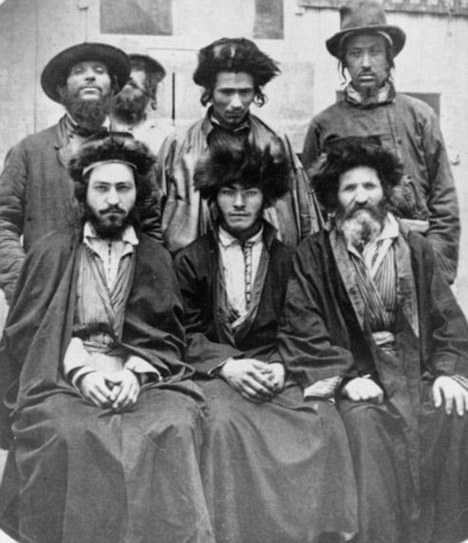
In the 19th and early 20th centuries, the racial classification of Jews in the United States was not settled, with many nativists describing them as "Mongoloid" and "Asiatic." The United States Bureau of Immigration had classified Jews as "Slavonic" during the 19th century, but the Dillingham Commission contended that linguistic and physical criteria, including the "Jew's nose", classified Jews further down the Caucasian pecking order, as Semites. A 1909 Census Bureau ruling to classify Syrians as "Mongolians", thus non-white and ineligible for citizenship, caused American Jewish leaders to fear that Jews would soon be denaturalized as well.
In 2013, more than 90% of U.S. Jews described themselves as white.However, the racial status of Jews has continued to engender debate, with some commentators arguing that all Jews are non-white.
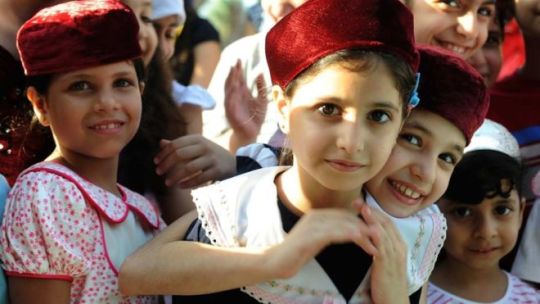
South Asian Americans constitute a broad group of ethnic groups and racial classification of each of these groups has varied over the years.
The classification of Indian Americans has varied over the years and across institutions. Originally, neither the U.S. courts nor the census bureau categorized Indians as a race because there were only negligible numbers of Indian immigrants in the United States. Various court judgements instead deemed Indians to be "white" or "not white" for the purposes of law.
Unlike Indian Americans, Sri Lankan Americans and Nepalese Americans have always been classified as "Asian". Before 1975, both groups were classified as "other Asian". In 1975, they were given their own separate categories within the broader Asian American category.
In 1909, Bhicaji Balsara became the first Indian to gain U.S. citizenship, as a Zoroastrian Parsi he was ruled to be "the purest of Aryan type" and "as distinct from Hindus as are the English who dwell in India”. Almost thirty years later, the same Circuit Court to accept Balsara ruled that Rustom Dadabhoy Wadia, another Parsi also from Bombay was not white and thefore not eligible to receive U.S. citizenship.
In 1923, the Supreme Court decided in United States v. Bhagat Singh Thind that people of Indian descent were not ‘white’ men, and thus not eligible to citizenship. The court conceded that, while Thind was a high caste Hindu born in the northern Punjab region and classified by certain scientific authorities as of the Aryan race, he was not ‘white’ since the word Aryan "has to do with linguistic and not at all with physical characteristics" and since "the average man knows perfectly well that there are unmistakable and profound differences" between Indians and white Americans.[71] Associate Justice George Sutherland wrote that Indians "cannot be properly assigned to any of the enumerated grand racial divisions.:
The U.S. Census Bureau has over the years changed its own classification of Indians. In 1930 and 1940, Indian Americans were classified as "Hindu" by "Race", and in 1950 and 1960, they were categorized as Other Race, and in 1970, they were deemed white. Since 1980, Indians and other South Asians have been classified according to self-reporting,with many selecting "Asian Indian" to differentiate themselves from peoples of "American Indian" or Native American background.

The earliest Finnish immigrants into the U.S. were colonialists who were Swedes in the legal sense and perhaps spoke Swedish. They settled in the Swedish colony, and were supposed to have assimilated into the British culture quickly.
More recent Finns were on several occasions "racially" discriminated against and not seen as white, but "Asian". The reasons for this were the arguments and theories about the Finns originally being of Mongolian instead of native European origin due to the Finnish language belonging to the Uralic and not the Indo-European language family.
On January 4, 1908, a trial was held in Minnesota about whether John Svan and several other Finnish immigrants would become naturalized United States citizens or not, as the process only was for "whites" and "blacks" in general, and district prosecutor John Sweet was of the opinion that Finnish immigrants were Mongols. The judge, William A. Cant, later concluded that the Finnish people may have been Mongolian from the beginning, but that the climate they lived in for a long time, and historical Finnish immigration and assimilation of Germanic tribes (Teutons)—which he considered modern "pure Finns" indistinguishable from—had made the Finnish population one of the whitest people in Europe. If the Finns had Mongol ancestry, it was distant and diluted. John Svan and the others were made naturalized U.S. citizens, and from that day on, the law forbade treating Finnish immigrants and Americans of Finnish descent as not white.
In the beginning of the 20th century, there was a lot resentment from the local American population towards the Finnish settlers because they were seen as having very different customs, and were slow in learning English. Another reason was that many of them had come from the "red" side of Finland, and thus held socialist political views

Beginning in the 1840s, negative assessments of the "Irish character" became more and more racialized. Irish people were considered brutish and (like blacks) were often compared to simians. The "Celtic physiognomy" was described as being marked by an "upturned nose [and] the black tint of the skin.

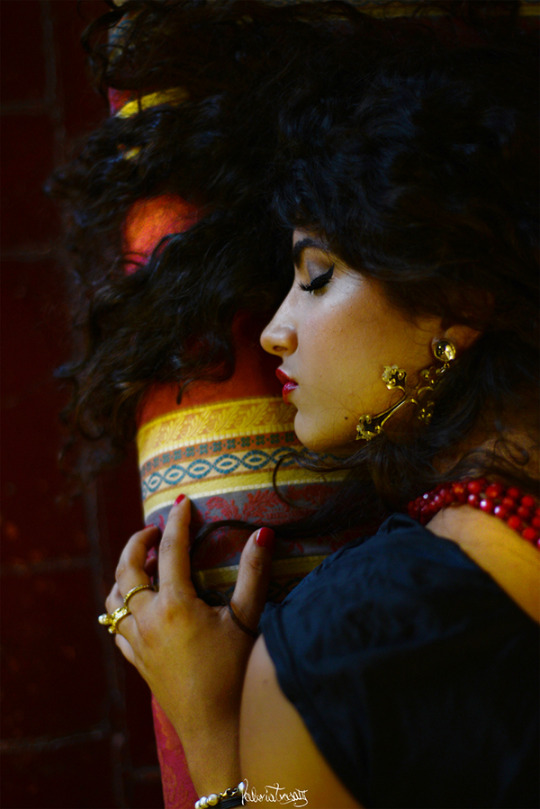
In certain parts of the South during the Jim Crow era, Italians "occupied a racial middle ground within the otherwise unforgiving, binary caste system of white-over-black." Though Italians were viewed as white for purposes of naturalization and voting, their social standing was that they represented a "problem at best." Their racial status was impacted by their appearance and that they did not "act" white, engaging in manual labor ordinarily reserved for blacks. The trial of nineteen Italian immigrants for the murder of New Orleans police chief David Hennessy in 1890, which ended in the lynching of eleven of them by a white vigilante group, sparked debate in the press over Italians supposed racial characteristics. Italians continued to occupy a "middle ground in the racial order" through the 1920s.
However, "color challenges were never sustained or systematic" when it came to Italians, who were "largely accepted as white by the widest variety of people and institutions" throughout the U.S. Even in the South, such as Louisiana, any attempts to disenfranchise them "failed miserably"
White has more to do with politics than biology,science or ethnicity - Khepri Neteru
#sicilian#invention of the white race#white myth#theodore allen#white#white people#african#european#bacon's rebellion#bacon rebellion#bacons rebellion#racism#irish#irish people#hamtic#hamtic people#khepri#khepri neteru
4K notes
·
View notes